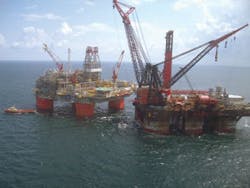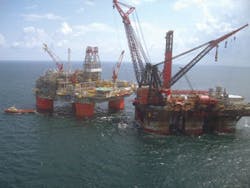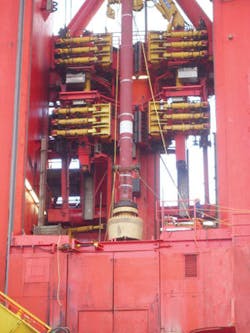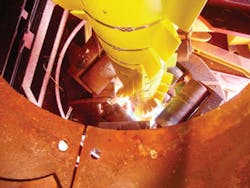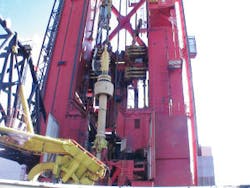Industry’s heaviest steel catenary risers installed in Gulf of Mexico
Jan van der Graaf, Heerema Marine Contractors
null
One of the more prominent developments in the deepwater scene in the Gulf of Mexico is the BP-operated Mardi Gras Transportation system, designed to gather over 1 MMb/d of oil and 1.5 bcf/d of gas for export from four fields: Mad Dog, Holstein, Thunderhorse, and Atlantis.
Throughout the various phases of construction and installation work on the project, numerous technology records have been broken.
Recently, Heerema Marine Contractors (HMC) completed the oil and gas export system for the BP-operated Thunderhorse project, which resulted in construction and installation of the heaviest steel catenary risers (SCRs) in the industry.
In the near future, HMC will eclipse its own record when the contractor undertakes fabrication and installation of the export risers for Atlantis, operated by BP as well.
However, it is not likely that these records will last very long. Successful exploration drilling in the 10,000-ft arena will lead to pipeline solutions that will challenge all major deepwater pipeline installation contractors in the coming years.
Deepwater construction
In November 2000, HMC was awarded the Mardi Gras Project, which called for installation of the export pipelines and SCRs for Holstein, Mad Dog, Thunder Horse, and Atlantis.
The overall workscope for HMC included installation of eight pipelines with an overall length of 330 km and diameters ranging from 16-28 in., 8 SCRs, and 20 in-line pipeline structures, in water depths varying between 1,300-2,200 m.
To accommodate this heavy-lift work, in 2001, HMC launched a deepwater investment program and converted the semisubmersible crane vessel (SSCV)Balderinto a deepwater construction vessel (DCV).
Features of the DCVBalderinclude a 1,050-metric ton J-lay system and a 650-metric ton A&R winch, which when operating in concert, enables lowering of pipelines with loads up to 1,050 metric tons. The combination of the semi’s J-lay tower with its two main cranes allows for handling of large structures such as PLETs and in-line sleds complete with mudmats.
In December 2002, an extensive test and trial program was performed onBalder, in preparation for its upcoming pipelay commitments. This testing program included installation of 10 km of 24-in. and 28-in. pipe, including in-line structures.
Subsequent to successful completion of the test and trial program, theBalder started performing installation work on the Mardi Gras project in April 2003. At press time, the vessel had successfully completed installation of all eight export pipelines and six SCRs.
In-between the contractor’s various Mardi Gras scope-of-work commitments,Balderperformed various other installations on BP-operated facilities -HolsteinandMad Dogspars, including hook-up work on theThunder Horsesemi’s mooring lines.
Between mid-December 2005 and early January 2006, the Mardi Gras Thunder Horse 20-in. and 24-in. SCRs were constructed and directly connected to theThunder Horse platform in 1,840 m of water. Installation of the field’s 24-in. SCR turned out to be the heaviest ever installed. Also, loads maxed-out at 400 metric tons during installation of the riser. In the event of a flooded pipeline, the J-lay system could safely manage maximum expected loads of 1,000 metric tons.
This SCR installation campaign initially started in June 2005, but was temporarily halted when theThunder Horse platform was adversely impacted by Hurricane Dennis.
Challenges
DuringBalder’s SCR installations, the vessel required in some cases installation windows of more than seven days, which is much more than the maximum predictable duration of a reliable weather window. This was the result of large required bending radii to set pipe on the seafloor, where space is limited due to mooring line patterns.
To minimize lost time in this weather window, it was essential that weld rejection was reduced to an absolute minimum. Installation of VIV strakes on large parts of the SCRs, and strain monitoring systems on two of the SCRs had to be as efficient as possible.
In the event that deteriorating weather conditions required the pipelay operation to be delayed, theBalder’s DP system in combination with its high J-lay capacity ensured that the vessel could remain on location without damage or loss of product.
Another significant challenge that needed to be addressed was in developing the weld procedure specification (WPS) for the industry’s first 24-in. heavy-wall SCRs; including the required weld area toughness, fatigue performance, and pipe-end fit-up criteria.
To meet these targets while maintaining weld rejection rates at an absolute minimum, a weld testing and qualification program was executed, which resulted in low cut-out rates (<5% average in the J-lay tower), despite extremely tough weld acceptance criteria.
During installation of the project’s export pipelines, theBalder handled numerous large in-line structures weighing up to 120 metric tons. The combination of the vessel’s heavy-lift cranes and the J-lay tower’s open structure proved to be very efficient in performing this work.
Future
In the coming months,Balder will undertake installation on the final phase of Mardi Gras. This phase of the program calls for installation of Atlantis’ export SCRs measuring 16 in. and 24 in., in 2,200 m of water, which will result in a new record in terms of maximum construction loads at 570 metric tons. In case of a flooded SCR, maximum loads of 1,200 metric tons are anticipated.
With oil majors and large independents now developing fields in water depths greater than 10,000 ft, installation loads in excess of 1,000 metric tons will become the norm, pushing the need to advance technology.•
